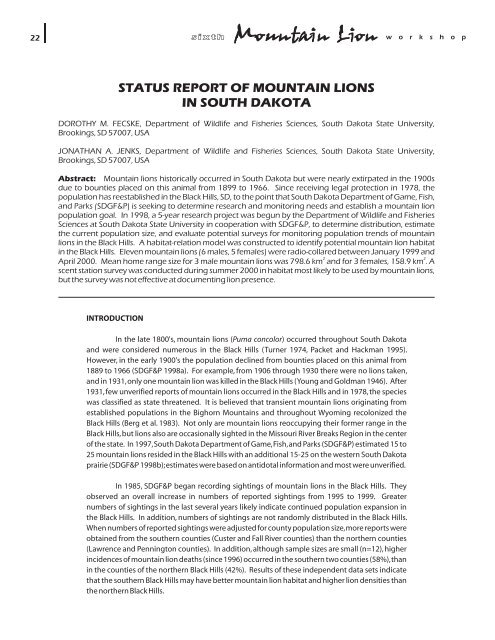PWD BK W7000-893 Proceedings.CDR - Mountain Lion Foundation
PWD BK W7000-893 Proceedings.CDR - Mountain Lion Foundation
PWD BK W7000-893 Proceedings.CDR - Mountain Lion Foundation
Create successful ePaper yourself
Turn your PDF publications into a flip-book with our unique Google optimized e-Paper software.
22<br />
STATUS REPORT OF MOUNTAIN LIONS<br />
IN SOUTH DAKOTA<br />
DOROTHY M. FECSKE, Department of Wildlife and Fisheries Sciences, South Dakota State University,<br />
Brookings, SD 57007, USA<br />
JONATHAN A. JENKS, Department of Wildlife and Fisheries Sciences, South Dakota State University,<br />
Brookings, SD 57007, USA<br />
Abstract: <strong>Mountain</strong> lions historically occurred in South Dakota but were nearly extirpated in the 1900s<br />
due to bounties placed on this animal from 1899 to 1966. Since receiving legal protection in 1978, the<br />
population has reestablished in the Black Hills, SD, to the point that South Dakota Department of Game, Fish,<br />
and Parks (SDGF&P) is seeking to determine research and monitoring needs and establish a mountain lion<br />
population goal. In 1998, a 5-year research project was begun by the Department of Wildlife and Fisheries<br />
Sciences at South Dakota State University in cooperation with SDGF&P, to determine distribution, estimate<br />
the current population size, and evaluate potential surveys for monitoring population trends of mountain<br />
lions in the Black Hills. A habitat-relation model was constructed to identify potential mountain lion habitat<br />
in the Black Hills. Eleven mountain lions (6 males, 5 females) were radio-collared between January 1999 and<br />
2 2<br />
April 2000. Mean home range size for 3 male mountain lions was 798.6 km and for 3 females, 158.9 km . A<br />
scent station survey was conducted during summer 2000 in habitat most likely to be used by mountain lions,<br />
but the survey was not effective at documenting lion presence.<br />
INTRODUCTION<br />
sixth <strong>Mountain</strong> <strong>Lion</strong> w o r k s h o p<br />
In the late 1800's, mountain lions ( Puma concolor)<br />
occurred throughout South Dakota<br />
and were considered numerous in the Black Hills (Turner 1974, Packet and Hackman 1995).<br />
However, in the early 1900's the population declined from bounties placed on this animal from<br />
1889 to 1966 (SDGF&P 1998a). For example, from 1906 through 1930 there were no lions taken,<br />
and in 1931,only one mountain lion was killed in the Black Hills (Young and Goldman 1946). After<br />
1931, few unverified reports of mountain lions occurred in the Black Hills and in 1978, the species<br />
was classified as state threatened. It is believed that transient mountain lions originating from<br />
established populations in the Bighorn <strong>Mountain</strong>s and throughout Wyoming recolonized the<br />
Black Hills (Berg et al. 1983). Not only are mountain lions reoccupying their former range in the<br />
Black Hills,but lions also are occasionally sighted in the Missouri River Breaks Region in the center<br />
of the state. In 1997,South Dakota Department of Game,Fish,and Parks (SDGF&P) estimated 15 to<br />
25 mountain lions resided in the Black Hills with an additional 15-25 on the western South Dakota<br />
prairie (SDGF&P 1998b);estimates were based on antidotal information and most were unverified.<br />
In 1985, SDGF&P began recording sightings of mountain lions in the Black Hills. They<br />
observed an overall increase in numbers of reported sightings from 1995 to 1999. Greater<br />
numbers of sightings in the last several years likely indicate continued population expansion in<br />
the Black Hills. In addition, numbers of sightings are not randomly distributed in the Black Hills.<br />
When numbers of reported sightings were adjusted for county population size,more reports were<br />
obtained from the southern counties (Custer and Fall River counties) than the northern counties<br />
(Lawrence and Pennington counties). In addition, although sample sizes are small (n=12), higher<br />
incidences of mountain lion deaths (since 1996) occurred in the southern two counties (58%),than<br />
in the counties of the northern Black Hills (42%). Results of these independent data sets indicate<br />
that the southern Black Hills may have better mountain lion habitat and higher lion densities than<br />
the northern Black Hills.
















